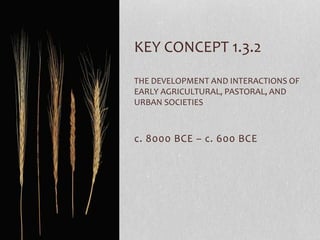
Key concept 1.3.2
- 1. c. 8000 BCE – c. 600 BCE KEY CONCEPT 1.3.2 THE DEVELOPMENT AND INTERACTIONS OF EARLY AGRICULTURAL, PASTORAL, AND URBAN SOCIETIES
- 2. Introduction and Overview From about 5,000 years ago, urban societies developed, laying the foundations for the first civilizations. The term civilization is normally used to designate large societies with cities and powerful states. While there were many differences between civilizations, they also shared important features. They all produced agricultural surpluses that permitted significant specialization of labor. All civilizations contained cities and generated complex institutions, such as political bureaucracies, armies, and religious hierarchies. They also featured clearly stratified social hierarchies and organized long-distance trading relationships. Economic exchanges intensified within and between civilizations, as well as with nomadic pastoralists.
- 3. Introduction and Overview As populations grew, competition for surplus resources, especially food, led to greater social stratification, specialization of labor, increased trade, more complex systems of government and religion, and the development of record keeping. As civilizations expanded, they had to balance their need for more resources with environmental constraints such as the danger of undermining soil fertility. Finally, the accumulation of wealth in settled communities spurred warfare between communities and/or with pastoralists; this violence drove the development of new technologies of war and urban defense.
- 4. Do Now 1. What is meant by the term civilization? 1. What do you think is meant by the term “specialization of labor,” and what factors contributed to its development in early societies? 2. List FIVE effects of the development of civilization.
- 5. II. The First States Emerged within Core Civilizations A. States were powerful new systems of rule that mobilized surplus labor and resources over large areas. Early states were often led by a ruler whose source of power was believed to be divine or had divine support and/or who was supported by the military. For example, the pharaohs of Egypt were often believed to be deities AND were also expected to take part in military expeditions.
- 6. Anointment By the Gods
- 7. B. As states grew and competed for land and resources, the more favorably situated — including the Hittites, who had access to iron — had greater access to resources, produced more surplus food, and experienced growing populations. These states were able to undertake territorial expansion and conquer surrounding states. Illustrative Example: The Hittites http://www.britishmuseum.org/explore/cultures/middle_east/hittites .aspx
- 8. C. Early regions of state expansion or empire building were Mesopotamia, Babylonia, and the Nile Valley.
- 9. Check for Understanding Please answer the following questions: 1. List THREE reasons why conflicts between early civilizations are beginnings? 1. How are leaders in the ancient world asserting their power?
- 10. D. Pastoralists were often the developers and disseminators of new weapons and modes of transportation that transformed warfare in agrarian civilizations.
- 11. New Weapons: Iron weapons Iron Weapons came into being around 1000 BC, and may be responsible for upsetting the social order. Iron was much cheaper (and stronger) than bronze. The aristocracy was no longer the only group with weapons and armor available.
- 12. Modes of Transportation: Chariots “Look, here comes a man in a chariot with a team of horses. And he gives back the answer: 'Babylon has fallen, has fallen! All the images of its gods lie shattered on the ground!'" Chariots seem to have originated in Mesopotamia in the third millennium BCE. The highly mobile two-wheeled war chariot carrying a driver and an archer armed with a short compound bow revolutionized military tactics after 1700 BCE. This expensive weapon spread throughout the Middle East and is thought to have reached Egypt with the Hyskos who took over Lower Egypt, though there is no factual evidence to support this view. The Egyptians improved the design of the chariot by making it lighter, changing the position of the chariot's axle so that the driver would stand closer to it and covering parts of the axle with metal in order to reduce the friction between it and the wooden wheel hub. Some wooden parts were strengthened by covering them with metal sleeves. These changes lightened the load on the horses and greatly improved their performance.
- 13. Exit Ticket 1. What is a civilization? What is allowing for the creation of these civilizations? 2. Describe two different types of interactions between ancient civilizations and their consequences.